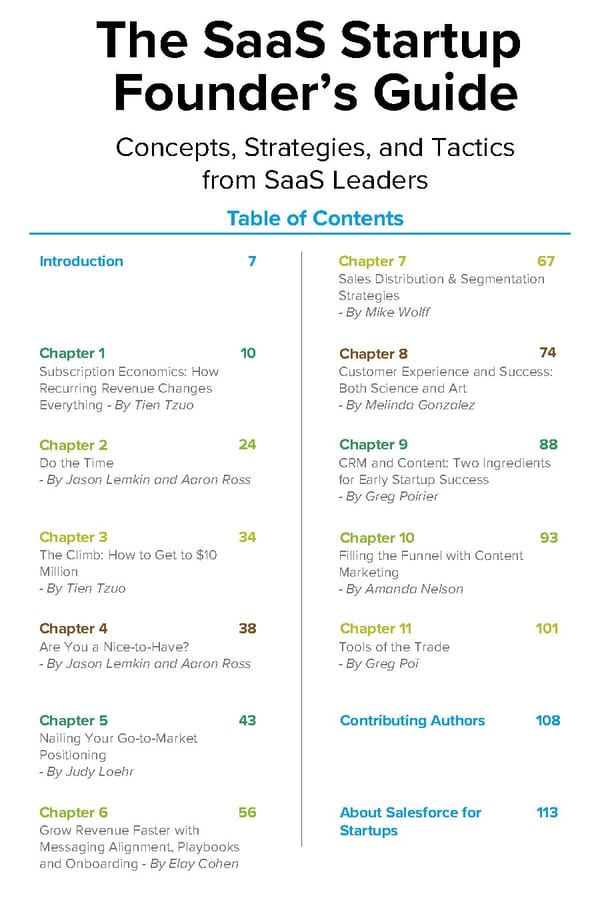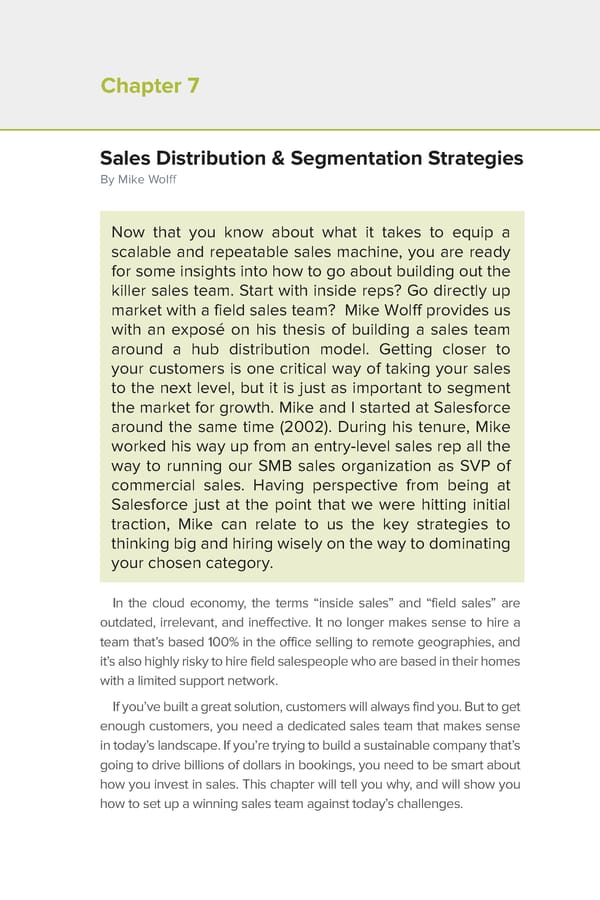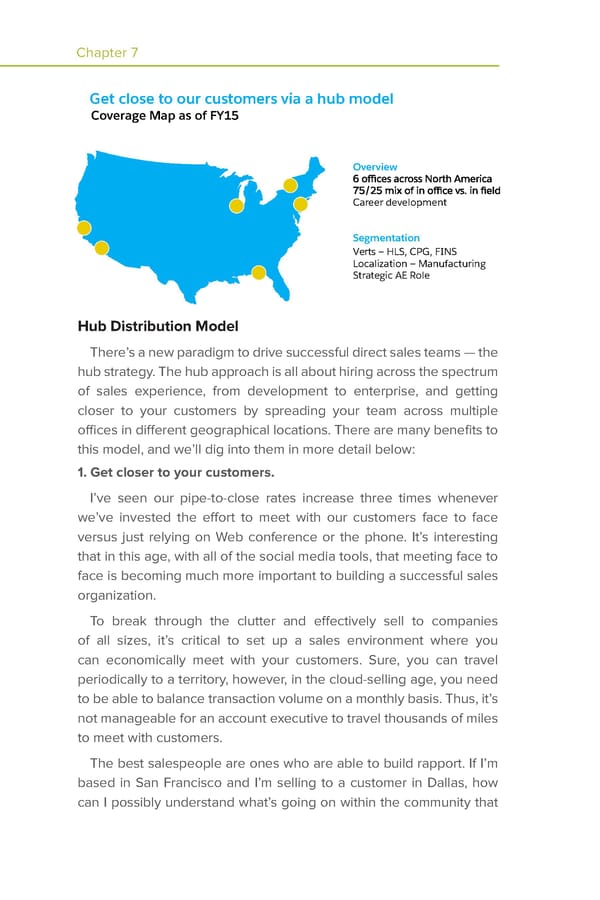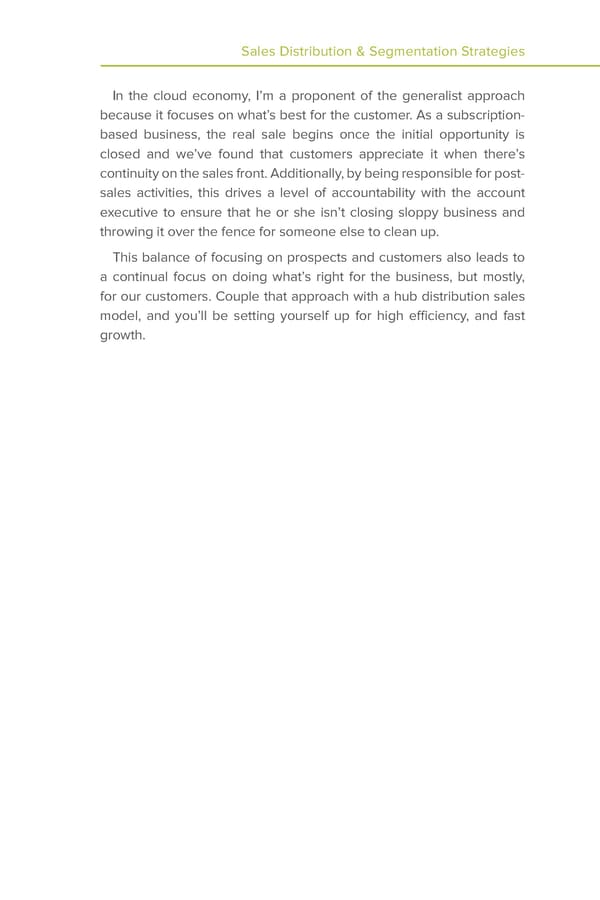Sales Distribution & Segmentation Strategies
By Mike Wolff, SVP, Global ISV Partners at Salesforce
The SaaS Startup Founder’s Guide Concepts, Strategies, and Tactics from SaaS Leaders Table of Contents Introduction 7 Chapter 7 67 Sales Distribution & Segmentation Strategies - By Mike Wolff Chapter 1 10 Chapter 8 74 Subscription Economics: How Customer Experience and Success: Recurring Revenue Changes Both Science and Art Everything - By Tien Tzuo - By Melinda Gonzalez Chapter 2 24 Chapter 9 88 Do the Time CRM and Content: Two Ingredients - By Jason Lemkin and Aaron Ross for Early Startup Success - By Greg Poirier Chapter 3 34 Chapter 10 93 The Climb: How to Get to $10 Filling the Funnel with Content Million Marketing - By Tien Tzuo - By Amanda Nelson Chapter 4 38 Chapter 11 101 Are You a Nice-to-Have? Tools of the Trade - By Jason Lemkin and Aaron Ross - By Greg Poi Chapter 5 43 Contributing Authors 108 Nailing Your Go-to-Market Positioning - By Judy Loehr Chapter 6 56 About Salesforce for 113 Grow Revenue Faster with Startups Messaging Alignment, Playbooks and Onboarding - By Elay Cohen
Grow Revenue Faster with Messaging Chapter 6 Alignment, Playbooks, and Onboarding Chapter 7 Sales Distribution & Segmentation Strategies By Mike Wolff Now that you know about what it takes to equip a scalable and repeatable sales machine, you are ready for some insights into how to go about building out the killer sales team. Start with inside reps? Go directly up market with a field sales team? Mike Wolff provides us with an exposé on his thesis of building a sales team around a hub distribution model. Getting closer to your customers is one critical way of taking your sales to the next level, but it is just as important to segment the market for growth. Mike and I started at Salesforce around the same time (2002). During his tenure, Mike worked his way up from an entry-level sales rep all the way to running our SMB sales organization as SVP of commercial sales. Having perspective from being at Salesforce just at the point that we were hitting initial traction, Mike can relate to us the key strategies to thinking big and hiring wisely on the way to dominating your chosen category. In the cloud economy, the terms “inside sales” and “field sales” are outdated, irrelevant, and ineffective. It no longer makes sense to hire a team that’s based 100% in the office selling to remote geographies, and it’s also highly risky to hire field salespeople who are based in their homes with a limited support network. If you’ve built a great solution, customers will always find you. But to get enough customers, you need a dedicated sales team that makes sense in today’s landscape. If you’re trying to build a sustainable company that’s going to drive billions of dollars in bookings, you need to be smart about how you invest in sales. This chapter will tell you why, and will show you how to set up a winning sales team against today’s challenges.
Chapter 7 Sales Distribution & Segmentation Strategies Get close to our customers via a hub model Coverage Map as of FY15 Overview Career development Segmentation Verts — HLS, CPG, FINS Localization — Manufacturing Strategic AE Role Hub Distribution Model There’s a new paradigm to drive successful direct sales teams — the hub strategy. The hub approach is all about hiring across the spectrum of sales experience, from development to enterprise, and getting closer to your customers by spreading your team across multiple offices in different geographical locations. There are many benefits to this model, and we’ll dig into them in more detail below: 1. Get closer to your customers. I’ve seen our pipe-to-close rates increase three times whenever we’ve invested the effort to meet with our customers face to face versus just relying on Web conference or the phone. It’s interesting that in this age, with all of the social media tools, that meeting face to face is becoming much more important to building a successful sales organization. To break through the clutter and effectively sell to companies of all sizes, it’s critical to set up a sales environment where you can economically meet with your customers. Sure, you can travel periodically to a territory, however, in the cloud-selling age, you need to be able to balance transaction volume on a monthly basis. Thus, it’s not manageable for an account executive to travel thousands of miles to meet with customers. The best salespeople are ones who are able to build rapport. If I’m based in San Francisco and I’m selling to a customer in Dallas, how can I possibly understand what’s going on within the community that
Chapter 7 Sales Distribution & Segmentation Strategies I’m selling into? I have no connection. Sure, I can google “Dallas” and get a cursory sense, however, I’m not a part of the community. And don’t fool yourself, your customers know it. And, they’re investing dollars with other companies that understand them better. 2. Build a multiyear career path from the entry level, to a more complex, enterprise-selling position. How incredible would it be if you had a pipeline of account executives and future leaders that understood your company culture, your selling motion, and your customers? This is another benefit of a hub-based selling environment. The hub model enables companies to hire at all levels of sales competence and sets in motion a career path that drives consistent sales success. When I interview salespeople at growing companies and ask them what’s inspiring them to evaluate new opportunities, the number one piece of feedback I receive is that there’s a lack of a career path. Why are you developing talent for others to leverage when your valued employees leave for other opportunities? The hub model helps address this challenge. 3. Diversify your recruiting portfolio in an ever-increasing competitive hiring environment. In such cities as San Francisco, New York, Austin, Boston, and Chicago, it’s becoming an increasingly competitive marketplace to hire top talent. This challenge will directly impact your ability to exceed bookings expectations. Therefore, to mitigate risk, it’s crucial to have a multi-hub approach in place. This strategy will provide you with the opportunity to transition territory and headcount to your offices with the most hiring momentum, and ensure that you’re being proactive with your business versus lowering the bar to bring on talent in a specific locale, which will then negatively impact you in ways far beyond a lack of bookings growth. 4. Orient teams in a selling environment that encourages constant collaboration and quick development. The coolest part about the hub model is the collaboration that can take place between a sales development rep with one month of selling experience and an account executive with 15 years of experience. As a result, in a hub model, team members develop faster and
Chapter 7 Sales Distribution & Segmentation Strategies impactful mentorships are formed early on, which further strengthen engagement. In the old world of inside and outside sales, the setup prevented this type of interaction from occurring, let alone developing. How to Segment the Market for Growth Cloud computing has democratized the potential for incredible technology to be purchased by companies of all shapes and sizes. On one hand, this is extremely exciting, and on the other hand, it creates an extremely difficult challenge for growing businesses to figure out how to successfully cover and execute against the market. As you think about developing and evolving your go-to-market strategy, here are some key principles to keep in mind. Market Segment Strategies CBU EBU ESMB CML ESB SMB MM GB ENTERPRISE Definition 1—20 emps 21—100 emps 101—500 emps 500+ (but not 2.000 Named Named Accts.) Accounts Primary Pipe Generation Marketing Pipe Generation and Maturation Pipe Maturation Objective Consistent investment Multiple touchpoints Sustained engagement Critical Success Low-friction trial Local relevance Account and Factors and conversion EBR and AE productivity industry relevance Optimized costs Data for prospecting Field enablement Velocity Seed and grow Heavy reliance on “1-2-3” cadence with Highly targeted and digital marketing launch of integrated account-based Marketing Mix (SEO/M, content campaign, call downs, programs to marketing, website, trials) and calls to action accelerate and close deals By Company Size By Company Size By Account Targeting By Role By Role By Industry By Industry (light) By role / Buying Center Sales SRs, AEs SRs, EBRs, AEs SRs, EBRs, AEs, Participation co-primes Decision-Makers 1 or 2 Multiple Many With Multiple Buying Centers HI VOLUME, LOW TOUCH HI VOLUME, LOW TOUCH
Chapter 7 Sales Distribution & Segmentation Strategies 1. Bifurcate sales development and account executive responsibilities. Many others, like Aaron Ross, former Salesforce team member and author of Predictable Revenue, have stressed the importance of having account executives focus on selling, and having sales development focus on building pipeline. While your account executives are always going to have some aspect of his or her job focused on pipeline generation, it’s critical that businesses put in place the infrastructure to support your sales organization with pipeline generation efforts. This arrangement ensures that you’re able to focus both on sales execution and market expansion. Without it, you’ll find, like many other businesses, that your growth will stall because your account executives won’t be able to successfully and consistently balance both responsibilities. 2. Understand how your customers buy. Put in place a sales framework that enables you to effectively sell to companies of varying size and complexity. Consider employee count, annual revenue, annual spend, and product interest when deciding how to segment your target markets. 3. Sell directly. For any fast-growing business, ultimately, there’s always going to be a point when you think about how to effectively expand your sales organization beyond your HQ or how to develop distribution capabilities abroad. While there are always going to be shades of gray, I’m a strong proponent of hiring, enabling, and growing a direct sales organization to help teams fully capture the market opportunity. Selling directly will help you: • Build internal account executive talent and future leadership talent. • Drive consistency with your company messaging, positioning, and overall sales/customer success experience. • Create a culture of wildly successful customers who feel connected to your team versus the resellers that are serving them. This helps build brand awareness and will have a positive ripple effect on your business.
Chapter 7 Sales Distribution & Segmentation Strategies 4. Identify top verticals, and again, know your customers. I often receive inquiries about how to approach verticals and why we selected key verticals such as financial services, health and life sciences, and consumer product goods. When thinking about your vertical strategy, some areas to consider are: • What does your customer data tell you? Take a look at the data and figure out who your customers are and whether it makes sense to put in place a vertical focus to further optimize bookings. • What’s the total available market (TAM) for the vertical that you’re looking to target? • How aligned are your product, marketing, and sales strategies around a particular industry focus? Creating an industry-focused sales team without product and marketing alignment isn’t going to be very efficient for your team. 5. Own the customer lifecycle. Another question that often comes up is whether or not fast-growing companies should create separate teams of hunter and farmer salespeople. The school of thought around this strategy is that further specialization in a certain part of the sales motion will lead to increased new business bookings and a more efficient add-on/upgrade process to drive incremental bookings. This decision depends upon the complexity of your sales process and the breadth of the products and services that you sell. At Salesforce, all of our core account executives are generalists. In other words, they’re responsible for driving a monthly bookings number and derive this business from both new business and add-on/upgrade bookings. While this has been our primary go-to-market model, due to the breadth of our services, we’re now at a point where we are actively evaluating the hunter/farmer model. As your business matures, there’s going to be a point at which you evolve from one type of organization to another. It may be at the very beginning or it may come 15 years down the road.
Chapter 7 Sales Distribution & Segmentation Strategies In the cloud economy, I’m a proponent of the generalist approach because it focuses on what’s best for the customer. As a subscription- based business, the real sale begins once the initial opportunity is closed and we’ve found that customers appreciate it when there’s continuity on the sales front. Additionally, by being responsible for post- sales activities, this drives a level of accountability with the account executive to ensure that he or she isn’t closing sloppy business and throwing it over the fence for someone else to clean up. This balance of focusing on prospects and customers also leads to a continual focus on doing what’s right for the business, but mostly, for our customers. Couple that approach with a hub distribution sales model, and you’ll be setting yourself up for high efficiency, and fast growth.




